| Article ID | Journal | Published Year | Pages | File Type |
|---|---|---|---|---|
| 2834189 | Molecular Phylogenetics and Evolution | 2011 | 16 Pages |
The Hymenoptera – ants, bees and wasps – represent one of the most successful but least understood insect radiations. We present the first comprehensive molecular study spanning the entire order Hymenoptera. It is based on approximately 7 kb of DNA sequence from 4 gene regions (18S, 28S, COI and EF-1α) for 116 species representing all superfamilies and 23 outgroup taxa from eight orders of Holometabola. Results are drawn from both parsimony and statistical (Bayesian and likelihood) analyses, and from both by-eye and secondary-structure alignments. Our analyses provide the first firm molecular evidence for monophyly of the Vespina (Orussoidea + Apocrita). Within Vespina, our results indicate a sister-group relationship between Ichneumonoidea and Proctotrupomorpha, while the stinging wasps (Aculeata) are monophyletic and nested inside Evaniomorpha. In Proctotrupomorpha, our results provide evidence for a novel core clade of proctotrupoids, and support for the recently proposed Diaprioidea. An unexpected result is the support for monophyly of a clade of wood-boring sawflies (Xiphydrioidea + Siricoidea). As in previous molecular studies, Orussidae remain difficult to place and are either sister group to a monophyletic Apocrita, or the sister group of Stephanidae within Apocrita. Both results support a single origin of parasitism, but the latter would propose a controversial reversal in the evolution of the wasp-waist. Generally our results support earlier hypotheses, primarily based on morphology, for a basal grade of phytophagous families giving rise to a single clade of parasitic Hymenoptera, the Vespina, from which predatory, pollen-feeding, gall-forming and eusocial forms evolved.
Graphical abstractFigure optionsDownload full-size imageDownload as PowerPoint slideHighlights► Hymenoptera are a monophyletic group as analyzed by 28S, 18S, COI and EF-1. ► A single origin of parasitism is supported with a monophyletic Vespina (Apocrita including Orussoidea). ► Molecular results in general do not support monophyly of Apocrita (excluding Orussoidea), thus questioning the single origin of the wasp-waist. ► Molecular results support previous hypotheses for higher-level groups within Hymenoptera, but not monophyly of Ichneumonoidea and Aculeata. ► Bayesian, Likelihood and Parsimony results (with third codon positions deleted) are in agreement for hypotheses of evolution of Hymenoptera.
